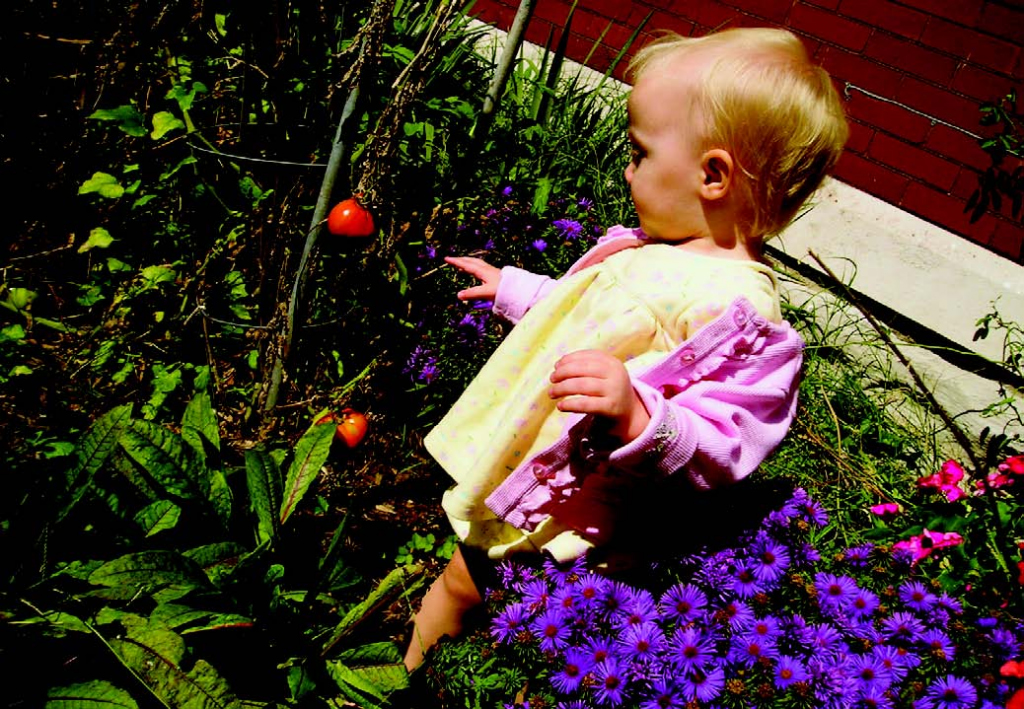by Elise Mori
I believe a garden needs children and children need gardens. Admittedly, a Japanese lifestyle usually precludes any kind of gardening, but whether it’s a window box or full-on landscaping, children love to take part in gardens and watch them gradually evolve. Right now is the perfect time to plan and plant your growing area, however large or small that might be.
If you only have space or energy for a window box, why not start small? Edamame pods are grown from soybeans and everything you need, from small packets of soil to sachets of beans, is available from hardware stores and larger supermarkets. Most apartments and houses in this country have a balcony for hanging futons, which is big enough for a few pots. Strawberries are easy to grow in containers and don’t need very much attention. Many other fruits can be grown in pots too, blueberries and blackcurrants, for instance, as well as figs and grapes, and also dwarf apple and pear trees, and, not forgetting, cherries. Many vegetables can also be grown in containers, and not only the dreaded decorative cabbages: corn is a striking and entertaining plant to grow, as are tomatoes, both the cordon and bush varieties.
Bulbs are a fast and easy way to get started in a garden, they hardly need any space and give really great results. There are spring planting and autumn planting varieties and perhaps the safest and most attractive are alliums (decorative garlic), which flower mid-summer.
Many people worry about the safety of ponds with small children, and justifiably so as under-fives can drown in a moment in only a few centimeters of water. A splash or bubble fountain is a good way to introduce water safely in the garden and many can be bought as self-contained units that are easy to install. Some of them are even solar powered so no need, even, to worry about the danger of trailing cables, although of course they will stop working at night. However, older children really enjoy a good-sized pond, which will soon attract all manner of wildlife such as birds and dragonflies and a few frogs will keep any slug and mosquito situation a little more under control. Some common garden plants are highly poisonous and can easily be fatal to small children, such as box (buxus), foxgloves (digitalis), rue (ruta), yew (taxus), lily-of-the-valley (convallaria), and lupin (lupinus) to name only a few of the most common. Teaching your children to never put anything that is growing in a garden or growing wild in their mouths or rub them onto their skin, literally, is vital. If you are moving into a garden with established plants and trees, please check to see what species you have inherited.
There are hundreds of websites to draw your inspiration from and websites that will send you seeds from all over the world. My favorite is www.gardenorganic.org.uk, whose philosophy is: “we do not inherit the earth from our ancestors, but borrow it from our children.” Also of note is www.bountifulgardens.org from the US. Please make sure that whatever seeds you import do not become invasive pests, which are a real danger in a non-native habitat and can seriously endanger wildlife. According to Japanese governmental guidelines, all plants and plant products (seeds, fruits, vegetables, grains, etc. are subject to quarantine on entering Japan and some pea and rice varieties are banned. Although it is perfectly legal to have seeds sent to you from abroad, the contents of the packet should be clearly stated on the outside; Customs inspection is free and should only take five days. Bulbs, live plants, roots, and sprouted cuttings should have “post entry quarantine” clearly written on the packet and will be subject to a year-long inspection period, so perhaps it’s better to shop locally for those: have a look at www.sakataseed.co.jp or, better still, visit their large and interesting main shop in Yokohama (details on their website).










